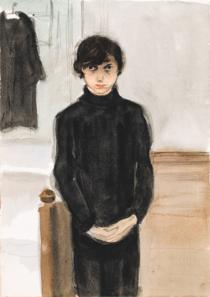
Before the Nazis took power in 1933 Jeanne Mammen earned her living as a commercial artist, selling her work to film producers, fashion magazines and satirical journals. Her work portrayed the vibrant life of the big city. She chronicled the nightlife of Weimar Berlin capturing scenes from bohemian dives and proletarian bars to elegant cabarets and exclusive Lesbian clubs.
This Part Two of two posts about Jeanne Mammen. You can find the first one here: The Watchful Eye of Jeanne Mammen.
She lived in the heart of the city at Kurfürstendamm 29 in a two room space that she had moved into with her sister in 1921. It was just a few doors from the Café Reimann.
At the end of her life in 1975 she descibed it an interview with Hans Kinkel in the Frankfurter Allgemeine Zeitung, “as nothing but gas lighting, two chairs, two easels.”
In a foretaste of Kristallnacht, the café was attacked by Nazi brownshirts in 1931. The mob had gathered in their hundreds to harass Jews leaving a nearby synagogue. It was Rosh Hashanah.
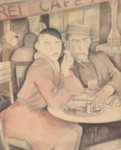
The café was a target because it was thought to be a Jewish rendezvous. The chairs and tables on the terrace were trashed and the window smashed.
Berlin was increasingly a city of political violence and factional classes between Communists and Nazis. Harassment turned into assault and random acts by small groups into organized and deadly riots that targeted those perceived to be Jewish and Jewish owned shops and businesses. Mammen joined the Communist party.
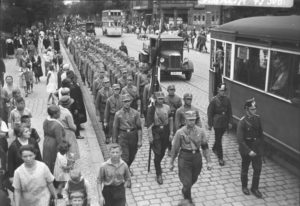
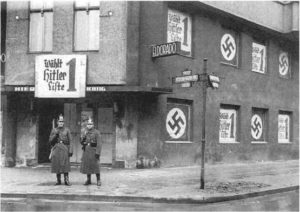
The last years of the Weimar Republic were marked by financial panic, unemployment and economic chaos. Political tensions erupted in violent street clashes. and brutal attacks. The Nazis were on the move in Berlin, militarizing the streets and mobilizing their forces.
There was a sensation of doom to be felt in the Berlin streets.
In 1933 it was no longer just thugs on the streets. Hitler had come to power. Everything changed. In 1938 that synagogue on Fasanenstrasse was burned to the ground.
Jeanne Mammen wrote:
When the Hitler era began, all the magazines and newspapers I worked for were banned or rectified – ‘Gleichschaltung’ . The end of my ‘realistic’ period. Transition to an aggressive painting style, of fragmenting the object (in contrast to the official art world). World War II: no oil paints, no canvas—all pictures from this period are painted with gouache on cardboard. Ration cards, unemployment registration, hard labor, bombing, forced training as a fireman. – Jeanne Mammen in her (one page) autobiography Outside Short Report (Äußerlicher Kurzbericht). Submiitted on the occasion of a 1974 exhibition.
Mammen’s portrayals – those of women in particular – drew the attention of the Nazis. After her participation in the spring exhibition of the “Verein der Künstlerinnen zu Berlin” [Association of Female Artists in Berlin] the attacks in the Nazi press began. They denouncing her style of portrayal and declared the subjects “Jewish”. The book for which she had prepared lithographs Les Chansons de Bilitis was banned from publication..
She Persisted, She Resisted
Many of those who opposed the regime – or were fearful for their safety and had the means – fled. Others stayed. Mammen had been forced into exile before and she chose to remain. She went into a self-imposed exile in Berlin and took her art underground. After the war this was called Internal Emigration.
Mammen was not alone in trying to escape the Third Reich and stay alive by Internal Emigration. Other artists did the same – Emil Dolde, Otto Dix, Max Pechstein, Hannah Höch, Käthe Kollwitz and Ernst Barlach among them.
Others made different choices. Wolfgang Gurlitt – who had sponsored the solo exhibition of Mammen’s art -started working for the Nazis and sold art to Joseph Goebbel’s Ministry of Propaganda.
Her friend, the Communist sculptor Hans Uhlmann, was jailed for distributing anti-fascist leaflets.
Mammen stayed home, locked the door and started painting in a whole new way.
She had never been abstract, cubist or expressionist artist. But now – in resistance and artistic protest – her art took a whole new direction. It became the kind of stuff the Nazis condemned as degenerate (entartete Kunst). In secret she produced the kind of work the Nazis hated right under their noses in the heart of the Nazi capital.
Four years after her Café Reimann (above) she painted another café terrace.
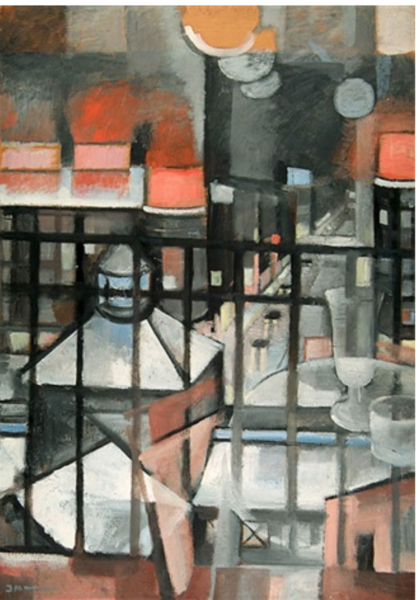
KaDeWe is the familiar name of the Berlin’s Kaufhaus des Westens (“Department Store of the West”)- the second largest department store in Europe. In June 1927, – Hermann Tietz – a Jewish owned partnership – took ownership. Nazi race laws compelled the company to aryanize the name to the Hertie Group. In 1943 an American bomber was shot down and crash landed onto the store. Most of the store was gutted by the ensuing fire. The re-opening of the first two floors was celebrated in 1950 as a mark of national recovery and the reconstruction of all floors was completed in 1956.
Mammen’s world was now one of fragmentation and loss.
She retreated into her love of French literature and translated the works of Arthur Rimbaud and Jean Cocteau. She translated the writings of Picasso. Her sister Mimi with whom she had shared the studio moved to Tehran. Her close friend Max Delbrück emigrated to America.
Deprived of her income, she registered as an unemployed commercial artist. She survived the years of dictatorship from 1933-45 with small commissions from friends as well as by selling used books and other items from a handcart. She continued to paint and draw.
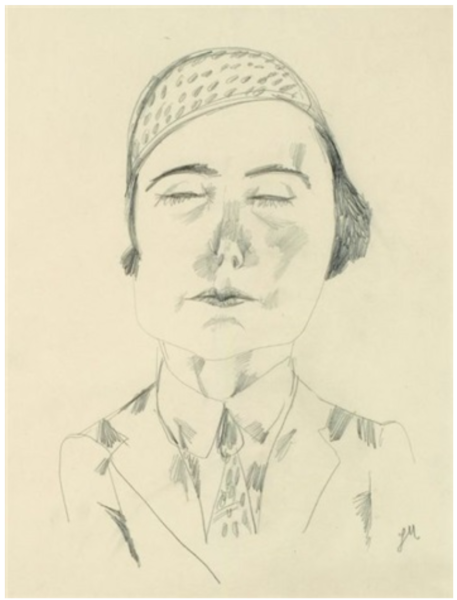
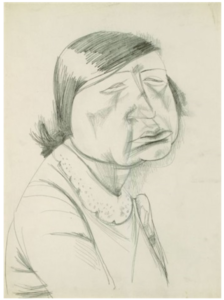
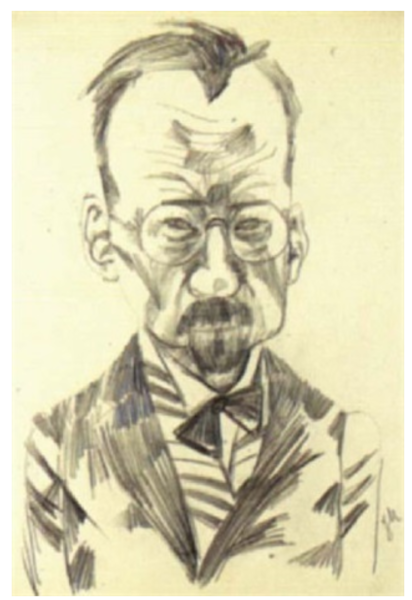
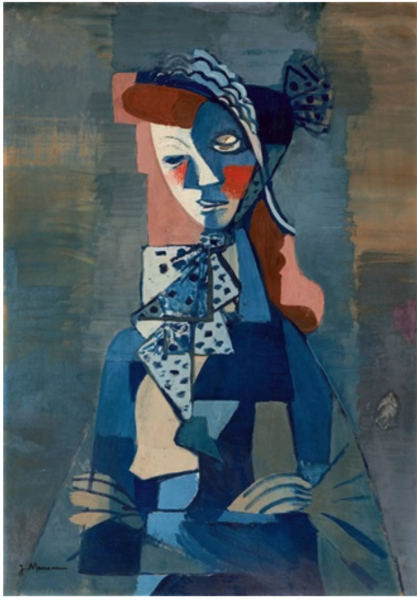
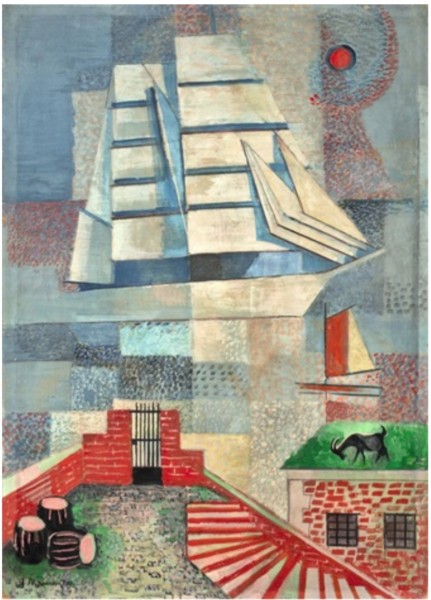

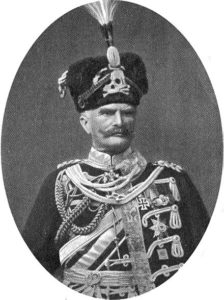 Below is her caricature of the Prussian born Field Marshall August von Mackensen, a veteran of the Franco-Prussian war of 1870 and a WW1 hero.
Below is her caricature of the Prussian born Field Marshall August von Mackensen, a veteran of the Franco-Prussian war of 1870 and a WW1 hero.
Mackensen had an ambiguous relationship with the Third Reich. he appeared in uniform at public events with Hitler yet he condemned the Night of the Long Knives murders and the German atrocities in Poland. His son – Eberhard von Mackensen (1889–1969), Generaloberst was convicted as a war criminal after the retaliatory murders of Italian civilians. A British military tribunal condemned him to death but the sentence was later commuted
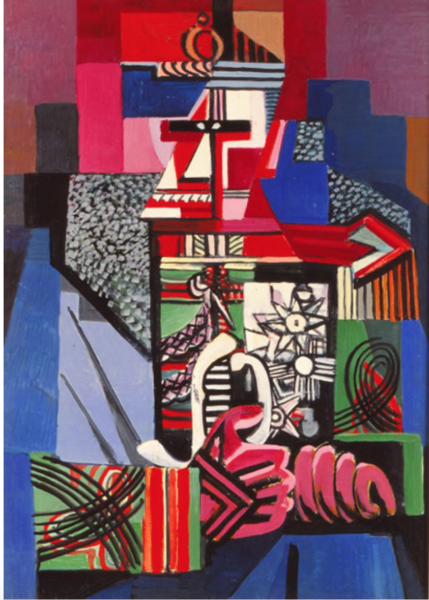
In 1937 Mammen had a brief respite from the oppression of the Nazi regime. She travelled to Paris then the host of the World’s Fair where Pablo Picasso presented Guernica.

At eleven feet tall and twenty five feet wide. Guernica is a monumental painting. The official theme of the Exposition was a celebration of modern technology. Picasso chose to paint his response to the bombing and destruction of the Basque town of Guernica during the Spanish Civil War.
It is reasonable to assume that Guernica had a powerful effect on Mammen. Her paintings after this visit reflect some of Picasso’s bursting distortions and also their emotional impact. Look for example of this picture of abject terror:
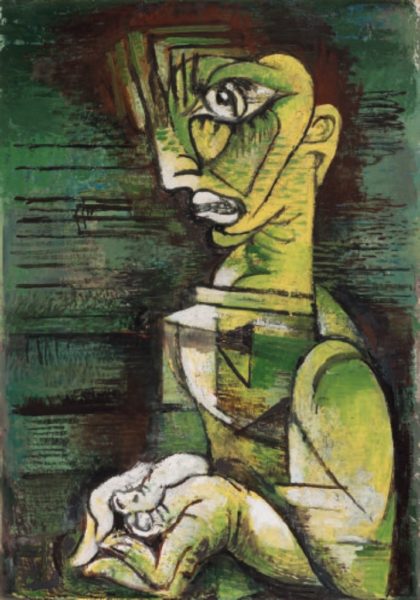
Living in Berlin Mammen knew first hand the terror of aerial bombardment. Berlin was subject to years sustained allied attacks that caused immense devastation and loss of life. The ferocious firestorm bombing intensified as the armies closed in from east and west. By May 1945, 1.7 million people (40% of the population) had fled. Thousands were killed.
By the end of the war, 192 of the 235 buildings on the Kurfürstendamm had been completely destroyed. Mammen’s building had been bombed but survived complete destruction.
She lived the life of a recluse and often did not leave her studio for days. When her building was bombed, and there was no electricity, she worked by candlelight. And when there were no candles she turned to working with her hands in the dark. Much of her artwork and personal belongings were destroyed but she continued working.
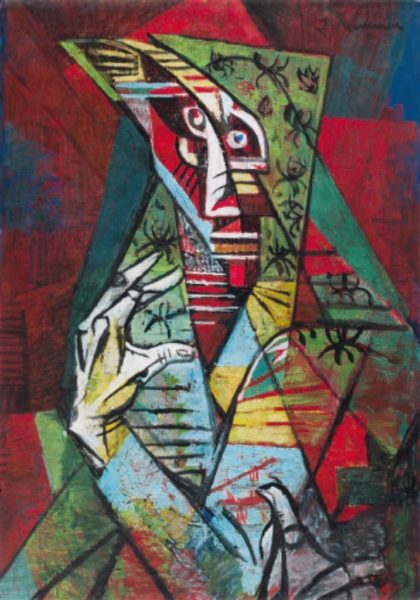
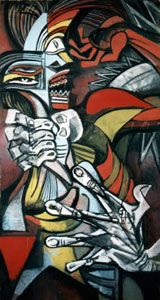
Twisted bodies, distorted faces eyes askew and wide with terror – Mammen adopted the visual language of Picasso and made it her own. Monstrous disembodied gnarled hands clutch and strangle strangled a tortured twisted figure.
While the Nazis clamped down on such degeneracy, Mammen kept symbolic abstraction alive on their doorstep.
Her work stands witness to the violence of her time and the brutality of the Third Reich. She was also keeping an artistic movement alive, helping tp preserve it in a time of wanton destruction and censorship. Such resistance was meant taking risks that she and her work would be discovered.
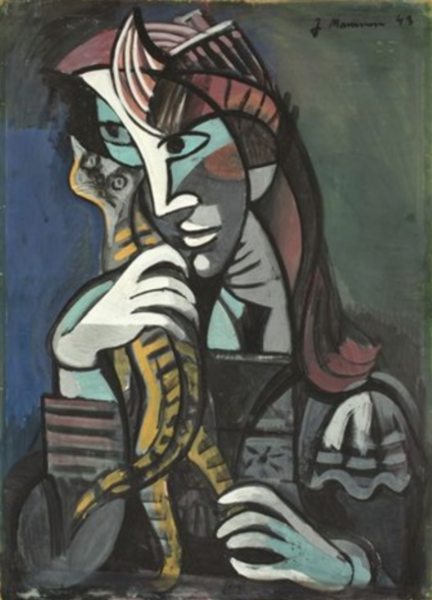
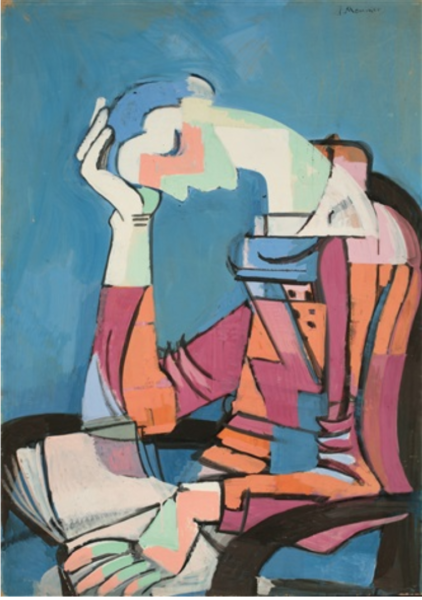
Mammen experimented with material and form. When paint was unobtainable she used what came to hand, processing what she scavenged in a city under siege.
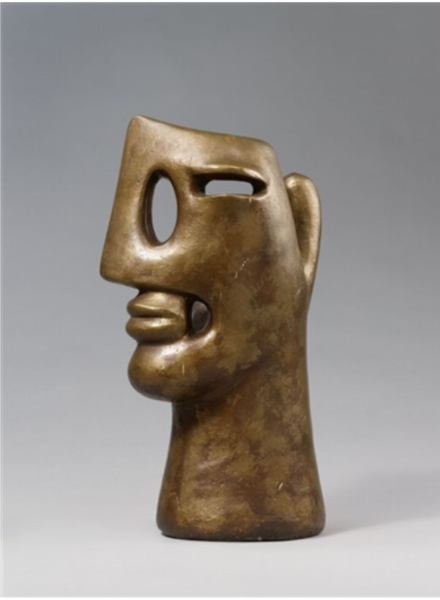
Near the end of the war, the Soviet army set up camp in the courtyard of her building. Mammen went out and gathered metal scraps and wire and incorporated them into a helical sculpture. After the war she used the string from the care packages that Max Delbrück sent from America.
After the War
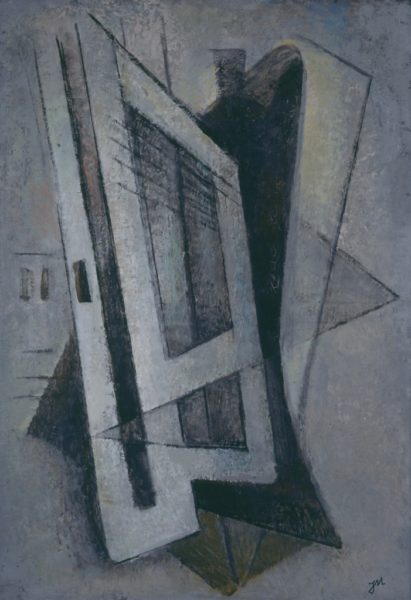
After the war, Mammen’s art shifted art towards the non-figurative, returning to the themes of her earlier work. She abstracted some of her earlier images and placed them in a new context.
She re-established contact with Max Delbrück and other Berlin friends now living in the U.S. and England. They sent her food, clothing and painting materials to ease the post-war austerity. In August of 1945, Her work was included in the show “After Twelve Years – Antifascist Painters and Sculptors Exhibit,” organized by her friend Hans Uhlmann.
Mammen resumed her commercial art career and scraped a living with illustrations for the political-satirical magazine Ulenspiegel (1946–1948) and the cultural magazine Athena (1947–1948). She joined the an artists cabaret – The Bathtub [Die Badewanne] – founded in 1949. It staged Surreal-Dadaistic performances and she created backdrops, scenery and costumes.
She took her place among the avant-garde artists of post-war Germany as they struggle to reflect on the recent past and find a way forward. When political and artistic controversy arose she again retreated to her private world and did not participate. She withdrew into her circle of friends, travelled and concentrated on her work in the studio.
There were solo exhibitions and her work began to get increased recognition.
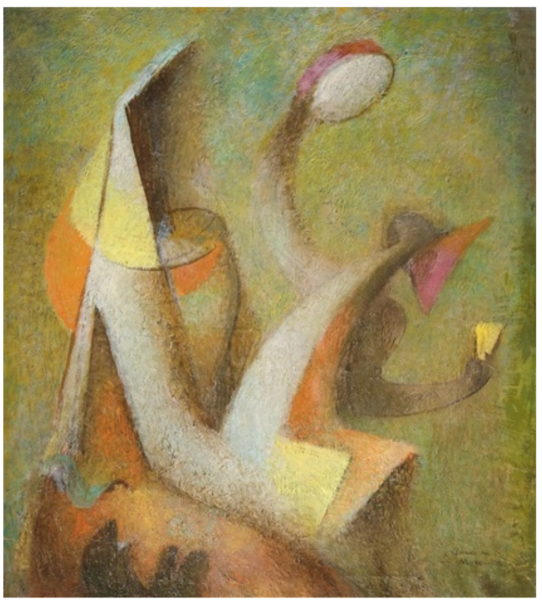
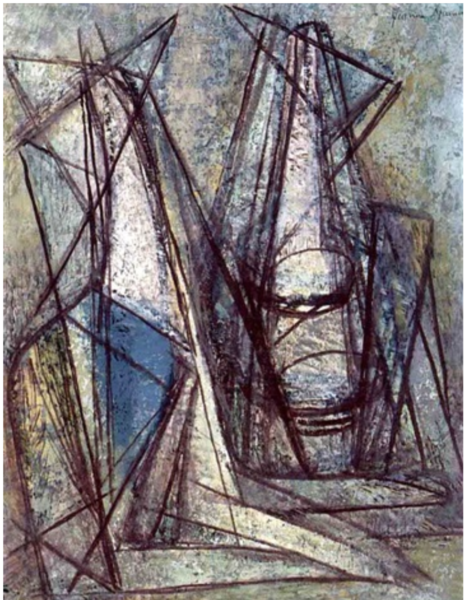
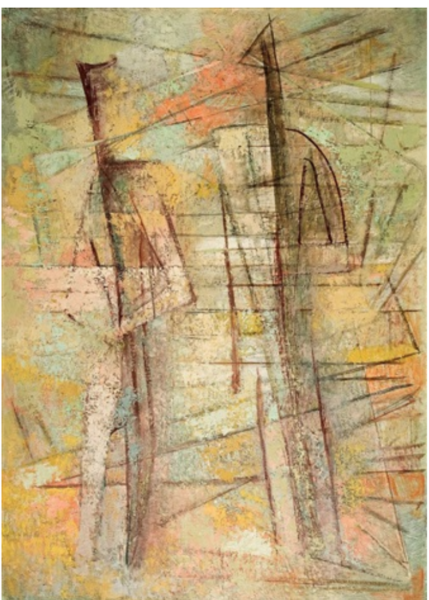
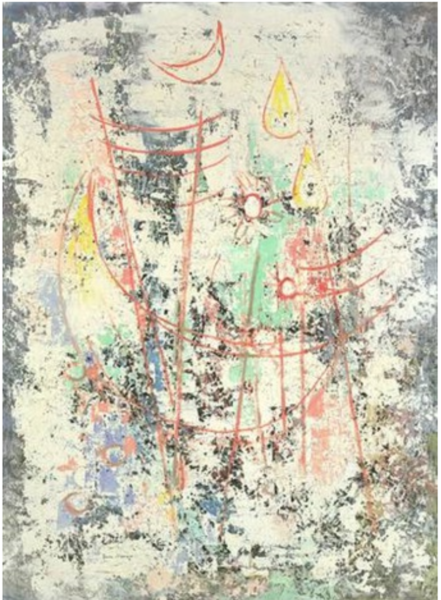
This looks like a stick figure hanging from a sardine can opener next to a liquorish all sort. Is it a pun. Is it a crank?
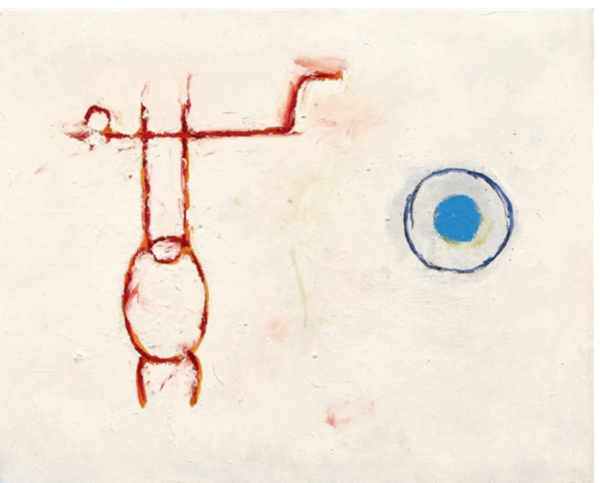
Most people – if they have heard of Mammen at all – think of her as an artist of the roaring twenties of Weimar Berlin. Mammen only gave one interview for which we have a record and in it she vehemently declared to the interviewer Hans Kinkel:
You must always write that my pictures were created between 1890 and 1975. …I have always wanted to be just a pair of eyes, walking through the world unseen, only to see others. Unfortunately one was seen. – Jeanne Mammen 1975
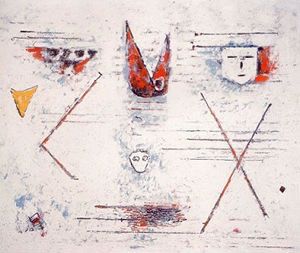
Mammen completed her last painting in October 1975 – a large white, multi-layered canvas on which she painted abstract symbols.
Friends entitled it Promise of a Winter / Verheißung eines Winters. After she died in 1976, they founded the “Jeanne-Mammen-Gesellschaft” (a non-profit organization). It has preserved her studio as a museum. Inside are the clutter and accumulations of over have a century – everything from balls of string to books, stones, postcards and kettles.
The final stage of her career continued to be experimental and her work full of the rich symbolism she had explored as a young artist now taken to a further dimension.

And cats. There always had to be cats.
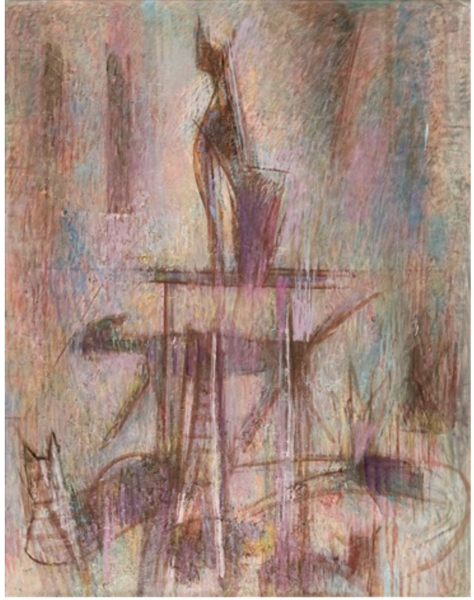
Sieben oder mehr Katzen / Seven or More cats, ca. 1947–1950

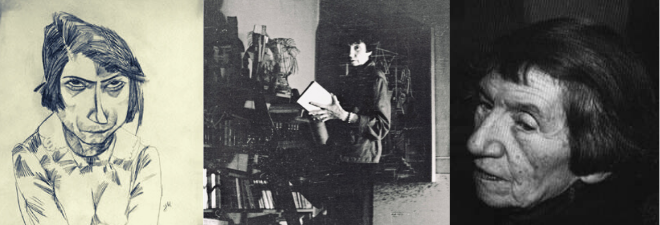
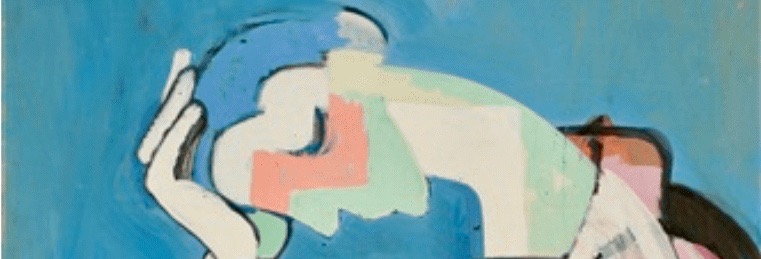


Wow this is wonderful. Thank you. Is the house / museum still open in Berlin? Have you been? I can’t seem to find anything on Google. It sounds fascinating!
I have not been. But I have just found this virtual tour: https://www.visitberlin.de/en/event/3d-time-travel-original-studio-jeanne-mammen
Most interesting
still recovering from Babylon Berlin.
know OD and GG v well
so this is marvellous
Danke
Thanks William. That Babylon Berlin was quite something! As was Berlin in that era. Good to hear from you.
I have found your pages after researching Jeanne Mammen for an art journalling project. I thank you for the amount of detail you have included, I have learnt so much about a new artist and I would love to see some of her art work “for real” one day.
I’m glad it was helpful Donna. Have to say I really enjoyed learning about Mammen’s life and work. Some people live extraordinary lives in extraordinary times. Maybe we all do. Best of luck with your project. I would love to know more about it.
Thanks Josie- always good stuff on your blog.
The contrast between her post 1933 art and her work from the 1920s – https://www.josieholford.com/mammen/ – is quite startling. And who knew there were official guidebooks to Babylon Berlin and so many categories of prostitution?
A fascinating and beautiful post, Josie. Thanks for drawing our attention to Mammen, I’m going to seek out more, now.